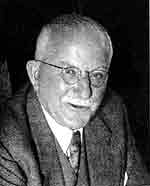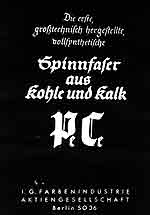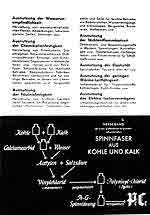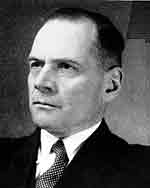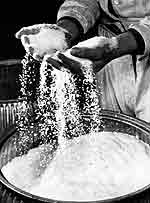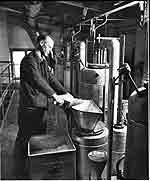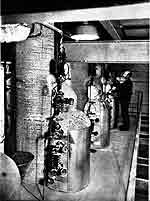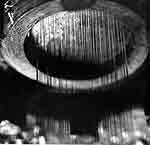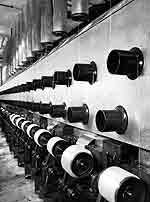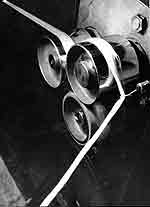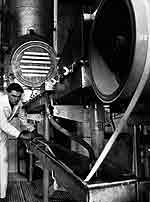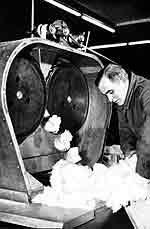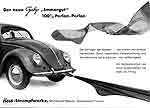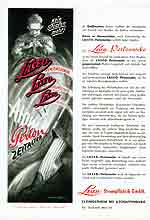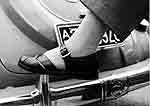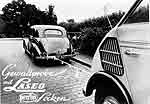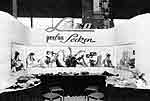|
| ||||||
4. Perlon |
||||
|
Enlarged graphics open in a new window. |
||||
|
In 1927, Professor Dr. Hermann Staudinger's research on the atomic structure of wool was the forerunner to the production of fully synthetic fibers. |
Professor Dr. Hermann Staudinger |
|||
|
In 1931, the chemists Hubert and C. Schönburg developed a method to spin a substance made from coal tar at the Agfa plant in Wolfen. This first fully synthetic staple fiber was a polyvinyl chloride fiber, called the PeCe fiber, and was trademarked by the company I.G.-Farben and widely marketed beginning in 1934. This chemical fiber possessed most of the qualities later featured in nylon and Perlon. However, due to its low melting point, this fiber was not suitable for textile production and was therefore mostly used for technical purposes. |
Brochure on the PeCe fiber, the forerunner of Perlon. |
|||
|
Brochure on the PeCe fiber, the forerunner of Perlon. |
||||

Schematic description of Perlon production.
|
In 1938, Perlon - a synthetic fiber similar to the American nylon - was invented by the German chemist Dr. Paul Schlack at I.G.-Farben. |
Paul Schlack, inventor of Perlon. |
||
|
|
|||
|
The base material caprolactam, attained from phenol in coal tar, is polymerized at a very high temperature to produce raw Perlon. While molten, the raw mass is pressed through a spinneret and then hardens to form filaments at air temperature. The first "test stocking" was produced by the company LBO in Oberlungwitz only a few months after the discovery of Perlon, and soon after, the first well-engineered fine lady´s stockings were produced. This invention was kept secret and declared as military defense material under the code name "Perluran" during Hitler's preparation for war. Perluran later became known as Perlon. |
Caprolactam, or nylon salt, the raw material for the production of Perlon, (...is attained from phenol (carbolic acid) in a multi-step process. Phenol is a by-product of coal tar, which is attained from coking plants). |
||
|
Caprolactam is filled into the filling funnel of a melting pot, (...where it is polymerized at a temperature of 260°C. Kunstseidefabrik Bobingen, 1950). |
|||
|
Polymerization in the Kunstseidefabrik Bobingen, 1950. |
|||
| Perlon was used as fabric for high pressure hose in airplane tires, as stiff bristles for cleaning weapons, for cords and ropes for parachutes - but also for lady´s stockings as a Christmas present for the wives of I.G.-Farben managers in 1943 and as reinforcement in socks used by the German armed forces. For the time being, the civil use of Perlon was unthinkable. |
Spinneret for the production of Perlon filaments. (Perlon is produced in the melt spinning process. The material is melted at high temperatures and continuously pressed through spinnerets by gear pumps. When cooled at room temperature, the mass congeals into fine filaments that can be pulled off and wound at a fast rate). |
||
|
Cone winding machine used to wind Perlon threads, 1950. |
|||
|
|
|||
| In 1949, the German Perlon industry began developing rapidly. By the second half of 1949, the Kunstseidefabrik Bobingen had already produced 10-15 tons of Perlon filament fibers. Now that the first German Perlon was available, lady's fine Perlon stockings starting appearing on the market. The Vereinigten Glanzstoffabriken A.G. were also pioneers in the Perlon field - in 1949 they opened a factory in Obernburg and in the following year in Oberbruch near Aachen to produce continuous Perlon filaments, which were necessary for the hosiery industry, which was based on the "Cotton" knitting process. |
Part of the stretching device. (...The non-stretched Perlon is then stretched to 4-5 times its length on cylinders. This process is what actually leads to the typical characteristics of Perlon: elasticity, durability and gloss). |
||
|
The greatest share of Perlon yarns produced were those with 60 and 30 den. Finer yarns with 20 den were also produced at the time. An additional important manufacturer of Perlon was the Farbenfabriken Bayer, which began to mass produce the "Bayer Perlon" fibers in June of 1950. |
In a different method of processing artificial silk and Perlon, the filaments of several spinnerets are merged to create one thick yarn. |
||
|
Perlon was blended with wool and rayon staple fiber to create "Perwollon", "Perlaine" and "Perzellon", but also used to make very durable knit pure Perlon socks and stockings.
|
The artificial silk or polyamide filament is crimped similarly to wool, (...and then cut into cotton-length fibers by rotating blades. These fibers are then spun into blended yarns with cotton, wool or rayon staple). |
||
| Beginning in 1952, there was enough high-quality Perlon available, so that the quantity of Perlon stockings and that of artificial silk stockings produced was about equal. The better fit and transparency of Perlon stockings eventually led to discontinuing the production of hosiery made from artificial silk. |
Gaby "Immergut" (...Perlon stocking made of pure Perlon, the post-war hosiery material known for its durability, app. 1952). |
|
Advertisement (...for Laseo Perlon socks, app. 1952). |
Laseo-Perlon socks (...photo taken app. 1952). |
"Gewaltprobe" (...Name of advertising campaign for Laseo Perlon socks, app. 1952). |
Trade Fair Display (...for Perlon socks by Laseo, based in Kleinostheim near Aschaffenburg, at the Spring Fair in Frankfurt/Main in 1953). |
